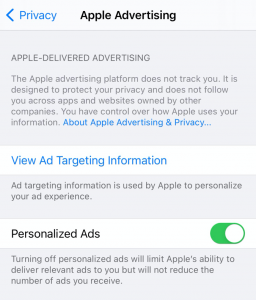Here’s What Apple’s Privacy Update Means for Your Facebook Ads
What are Apple’s new privacy changes?
Apple is launching a new privacy feature that requires all apps to ask for explicit permission to track users. This feature, called App Tracking Transparency, will be included in an iOS 14 update in spring 2021.
From an iPhone user’s perspective, this means you’ll receive a pop-up notification in every app asking if you want to allow tracking. If you opt in, then the app can track you and use the collected data to deliver personalized ads.
What is Apple IDFA?
IDFA, or Identifier for Advertisers, is the system that Apple uses to track and identify iOS users across apps and websites, all without revealing personal information. IDFAs are critical for marketers, because they allow us to accurately track users and use data to deliver relevant ads.
Currently, iOS users can opt out of IDFA by turning on a privacy setting called Limit Ad Tracking (LAT). This setting does not stop users from receiving ads, but the ads will no longer be personalized. As of 2020, 31.5% of American iOS users have enabled LAT. With the upcoming shift to an opt-in model, marketers are concerned that even more iPhone users will opt out of tracking.

How will the iOS 14 update affect Facebook?
If users do not opt in to tracking, the effectiveness of Facebook’s tracking pixel will decrease. What does this mean for your Facebook ads?
- Targeting options will be hindered. You will not be able to target users as accurately or with the same level of hyper-personalization.
- Conversion reporting will be less accurate, since you cannot track the user’s behavior after viewing your ad.
- Remarketing campaigns will be less effective, since you cannot remarket based on the user’s previous behavior.
- Lookalike audiences will be less accurate, since these audiences are generated based on user behavior.
With all of these factors combined, advertisers may begin to see weaker results on their Facebook ad campaigns. Note that this will disproportionately affect Audience Network ads (ie. ads in third-party mobile apps), rather than ads delivered on Facebook itself.
Facebook is fiercely contesting Apple’s new iOS policy, but they will still be required to display Apple’s pop-up consent prompt, or else the Facebook app would be blocked from the App Store.
What does this mean for digital marketers?
The increasing focus on privacy puts users’ interests at heart, but will cause a major shake-up in the digital advertising world.
Marketers have come to rely on tracking data to deliver highly personalized, targeted ads to users. As access to this type of data becomes more limited, marketers will need to start using other strategies to ensure ads find the right audiences.
- Track conversions with UTMs. The Facebook algorithm will not be able to optimize for conversion goals as effectively if iOS users don’t opt in to tracking. To get the most out of Facebook’s built-in optimization, try running campaigns with other objectives (ie. website traffic) and rely on your own tracking to measure conversions. If you use campaign URLs and Google Analytics, your UTMs will help you understand which ads drove conversions.

- Cast a wider net. Focus on ad creative with wide, general appeal, rather than a hyper-specific message that would only appeal to a narrow audience. In some cases, advertisers may find broad targeting more effective because it helps you expand beyond your core audience.
- Use context-based ad placements. In our increasingly privacy-conscious world, context may start to be a better bet than audience targeting, and Facebook may no longer be the best place for your ads. Consider doing a digital ad buy where you can control which sites display your ad. For example, a health food brand might choose to advertise on health and wellness sites, where they can expect to reach like-minded consumers.
Privacy has become a top concern for consumers and marketers alike. Apple’s privacy updates are not the first to impact digital marketers (hello, GDPR!) and they won’t be the last, so it’s on us as marketers to adapt.
If you have questions about how to get the most out of your marketing budget amidst this changing landscape, let’s talk.


